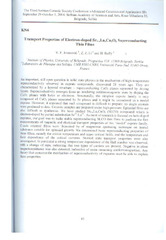Prikaz osnovnih podataka o dokumentu
Transport Properties of Electron-doped Sr1-xLaxCuOδ Superconducting Thin Films
| dc.creator | Jovanović, Vladimir P. | |
| dc.creator | Li, Z.Z. | |
| dc.creator | Raffy, H. | |
| dc.date.accessioned | 2023-10-20T11:32:00Z | |
| dc.date.available | 2023-10-20T11:32:00Z | |
| dc.date.issued | 2014 | |
| dc.identifier.isbn | 978-86-915627-2-4 | |
| dc.identifier.uri | http://rimsi.imsi.bg.ac.rs/handle/123456789/2159 | |
| dc.description.abstract | An important, still open question in solid state physics is the mechanism of high-temperature superconductivity observed in cuprate compounds, discovered 28 years ago. They are characterized by a layered structure - superconducting CuO2 planes separated by doping layers. Superconductivity emerges from an insulating antiferromagnetic state by doping the CuO2 planes with holes or electrons. Structurally, the simplest cuprate family is only composed of CuO2 planes separated by Sr planes and it might be considered as a model cuprate. However, it appeared that such compound is difficult to prepare: no single crystals were produced to date. Ceramic samples are prepared under high pressure. Epitaxial films are also difficult to synthesize. We have studied Sr1-xLaxCuOδ (SLCO) compound which is electron-doped by partial substitution Sr2+/La3+. As most of research is focused on hole-doped cuprates, our goal was to make stable superconducting SLCO thin films to perform the first measurements of magnetic and electrical transport properties of this "model" cuprate family. C-axis oriented films were deposited by rf magnetron sputtering technique on heated substrates suitable for epitaxial growth. We determined basic superconducting properties of these films, namely the critical temperature and upper critical fields, and the temperature and field dependence of the critical currents. Normal state transport properties were also investigated. In particular a strong temperature dependence of the Hall number was observed, with a change of sign., indicating that two types of carriers are present. Negative in-plane magnetoresistance was also detected, indicative of some remaining antiferromagnetism. Any theory that concerns the mechanism of superconductivity of cuprates must be able to explain these properties. | sr |
| dc.language.iso | en | sr |
| dc.publisher | Serbian Ceramic Society | sr |
| dc.rights | openAccess | sr |
| dc.rights.uri | https://creativecommons.org/licenses/by/4.0/ | |
| dc.source | 3rd Serbian Ceramic Society Conference “Advanced ceramics and applications” – ACA III, Belgrade | sr |
| dc.subject | e-doped cuprates | sr |
| dc.subject | SLCO | sr |
| dc.subject | superconductivity | sr |
| dc.subject | normal state | sr |
| dc.subject | electronic transport properties | sr |
| dc.title | Transport Properties of Electron-doped Sr1-xLaxCuOδ Superconducting Thin Films | sr |
| dc.type | lecture | sr |
| dc.rights.license | BY | sr |
| dc.citation.spage | 43 | |
| dc.identifier.fulltext | http://rimsi.imsi.bg.ac.rs/bitstream/id/5757/ACAIII_2014_abstract.pdf | |
| dc.identifier.rcub | https://hdl.handle.net/21.15107/rcub_rimsi_2159 | |
| dc.type.version | publishedVersion | sr |

